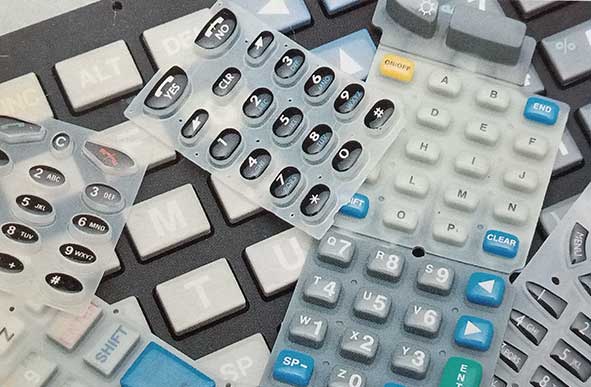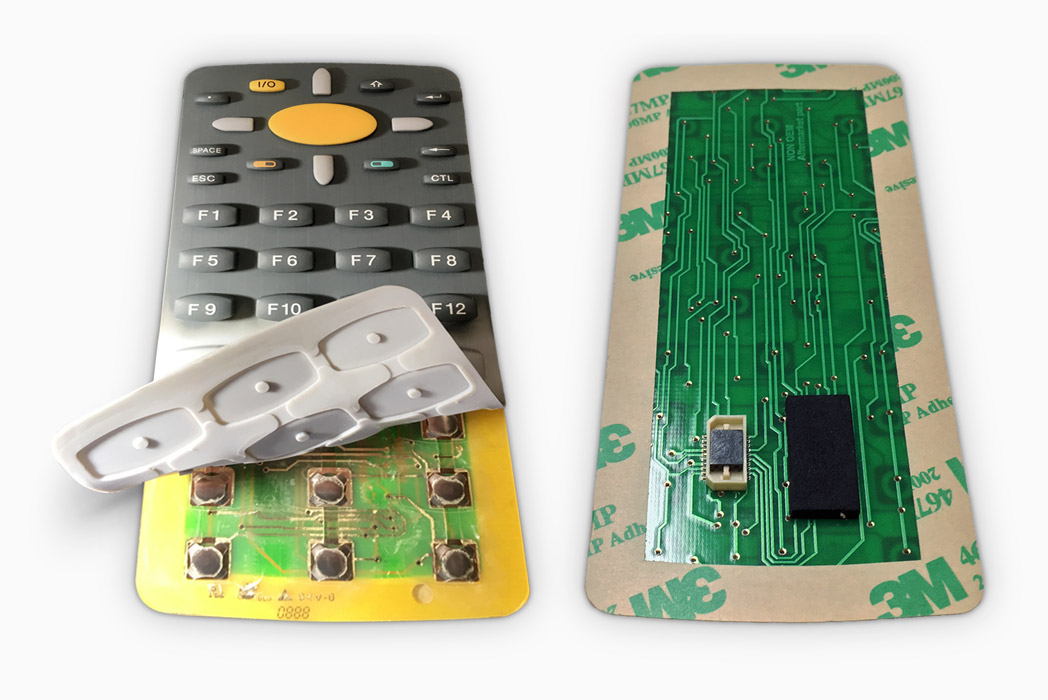A Comprehensive Guide to the Manufacturing and Processing of Rubber Keypads for Optimal Performance
The production and handling of rubber keypads play a necessary role in their performance and usability. Material selection, design precision, and innovative manufacturing methods significantly impact their longevity and effectiveness. Understanding these components is important for developing high-grade items. As different technologies arise in this area, discovering their effects could expose new standards for functionality and customer experience. What essential facets will form the future of rubber keypads?
Understanding Rubber Keypads: Materials and Types
Rubber keypads are vital parts in plenty of tools, using a balance of toughness and tactile feedback. These keypads are largely made from silicone or artificial rubber, products chosen for their flexibility and durability. Silicone rubber, particularly, is preferred for its outstanding temperature level resistance and longevity, making it optimal for different applications, from customer electronic devices to industrial machinery.
There are several types of rubber keypads, consisting of dome switch keypads, which make use of a dome-shaped mechanism that gives responsive feedback when pushed. Furthermore, there are likewise level keypads, which include a smooth surface and are usually made use of in medical tools and remote controls. The option of product and type influences the keypad's efficiency, really feel, and general user experience. Comprehending these aspects is crucial for suppliers and designers intending to produce reputable and reliable user interfaces in their items.
The Production Process: From Style to Manufacturing
The manufacturing process of rubber keypads involves numerous important stages, beginning with design and ending with manufacturing. At first, developers develop comprehensive specifications and models, assuring the keypad meets aesthetic and practical needs. Computer-aided layout (CAD) software program is typically made use of to imagine the design and functions prior to continuing.
As soon as the design is wrapped up, product choice is vital, with options typically including silicone or all-natural rubber. In the following stage, mold and mildews are developed based on the approved layouts, which will certainly form the keypads during manufacturing.
Following mold and mildew creation, the production phase commences, where rubber is blended with ingredients to boost performance. The blend is after that put into mold and mildews and subjected to warmth and stress, enabling it to heal and solidify.
The completed keypads undergo quality checks to confirm they satisfy established requirements, followed by packaging for distribution. This comprehensive process guarantees peak efficiency in the last item.
Key Strategies in Rubber Molding
In the domain name of rubber keypads, numerous molding techniques play a critical role in determining the top quality and functionality of the final product. One common method is compression molding, where raw rubber is put in a heated mold and mildew and stress is used, permitting effective automation and uniformity. An additional substantial method is shot molding, which entails infusing heated rubber right into a mold, providing greater accuracy and complicated shapes. Transfer molding, a hybrid of both methods, is additionally made use of, particularly for complex designs, as it combines the benefits of both procedures. In addition, liquid silicone rubber (LSR) molding is gaining grip because of its adaptability and resilience, making it excellent for high-performance applications. Each strategy has one-of-a-kind characteristics, affecting variables such as cycle time, material waste, and manufacturing expenses. Selecting the appropriate molding strategy is necessary for achieving peak performance in rubber keypads.
Surface Area Finishing and Texturing Options
Surface finishing and texturing options play a necessary duty in boosting the tactile experience and visual charm of rubber keypads. Makers employ numerous strategies to produce unique surface area attributes that impact individual communication and product style. Common ending up techniques include matte, shiny, and satin surfaces, each providing various visual effects and grip levels. Texturing options, such as increased patterns, grooves, or stippling, additionally boost capability by improving grip and minimizing slippage throughout usage.
In addition, details appearances can be tailored to satisfy ergonomic needs, supplying comfort during extended usage. The option of surface area finishes and textures can be affected by the desired application of the keypad, whether it be for consumer electronic devices, vehicle controls, or industrial tools. Eventually, mindful factor to consider of these options contributes substantially to individual satisfaction and overall product efficiency, making them important elements in the layout and manufacturing procedure of rubber keypads.
Top Quality Control Measures in Rubber Keypad Manufacturing
Quality assurance steps in rubber keypad manufacturing are crucial for making certain item reliability and efficiency. These procedures include product selection criteria, rigorous testing treatments, and strict last inspection standards. Together, they create an extensive structure that helps makers promote high quality throughout the production procedure.

Material Option Standards
Picking the proper products for rubber keypads is important, as it straight impacts their longevity, individual, and capability experience. Key standards for material selection consist of tensile stamina, durability, and environmental resistance. The selection of rubber substance, such as silicone or thermoplastic elastomer (TPE), plays a vital function in accomplishing wanted tactile responses and longevity. Furthermore, variables like chemical compatibility, temperature stability, and UV resistance must be taken into consideration to assure maximum performance in various applications. Manufacturers need to additionally assess the simplicity of handling and cost-effectiveness of materials, stabilizing quality with budget restraints. Inevitably, the right material option not only boosts the keypad's efficiency but additionally contributes to total product top quality and customer complete satisfaction.
Evaluating Procedures Implemented
After determining the proper materials for rubber keypads, extensive screening treatments are implemented to validate that the last products satisfy market criteria and consumer expectations. These procedures normally consist of mechanical testing, which evaluates the toughness and elasticity of the rubber under different conditions. Furthermore, environmental screening analyzes the keypads' efficiency under temperature changes, moisture, and exposure to chemicals. Electrical screening verifies the keypads function appropriately with electronic parts, verifying responsiveness and conductivity. Tactile comments is evaluated to guarantee customer fulfillment. These considerable screening measures are important in recognizing any kind of inconsistencies or problems before automation, inevitably enhancing the integrity and performance of rubber keypads in their desired applications.
Last Assessment Standards
Extensive last evaluation standards are important in rubber keypad production to assure that each system satisfies the defined standards for performance and look. This process typically entails visual assessments to determine any kind of surface problems, such as discoloration or flaws. Furthermore, tactile evaluations site web ascertain that the keypads react properly to touch, keeping the required level of sensitivity. Sturdiness examinations might also be conducted, mimicing long term use to validate the long life of the keypad under different conditions. Adherence to sector regulations and customer requirements is verified to maintain quality guarantee. By executing these extensive assessment procedures, manufacturers can greatly reduce the danger of defects, making sure that the final item is dependable and fulfills consumer assumptions, inevitably boosting customer satisfaction.
Advancements in Rubber Keypad Technology
As technology proceeds to develop, advancements in rubber keypad innovation are improving individual interfaces across numerous sectors. One significant advancement is the integration of capacitive touch sensing units within rubber keypads, allowing for a more receptive and flexible individual experience. This innovation allows individuals to connect with gadgets via touch, improving functionality without sacrificing the responsive feedback that rubber keypads are known for.
Furthermore, improvements in material solutions have actually resulted in the development of even more resilient, weather-resistant rubber, making keypads suitable for outside and Discover More Here industrial use. Improved printing techniques likewise enable for high-resolution graphics and backlighting options, boosting exposure and aesthetic appeal.

Moreover, developments in making procedures, such as 3D printing, are enabling personalized layouts and rapid prototyping, streamlining production timelines. These developments collectively contribute to a lot more effective and straightforward rubber keypads, ensuring they meet the needs of modern applications while maintaining their core advantages.
Best Practices for Design and Functionality
Creating efficient rubber keypads calls for careful evaluation of both looks and performance. Rubber Keypads. A well-designed keypad ought to stabilize ergonomic concepts with aesthetic charm to enhance user experience. Trick factors consist of size, shape, and spacing of buttons, guaranteeing they are easy to press while stopping accidental activation. Making use of contrasting appearances and shades can improve exposure and responsive feedback, assisting individuals in differentiating in between tricks
Additionally, the option of materials plays a necessary role; premium rubber compounds can improve durability and resistance to use. It is likewise crucial to think about the integration of features such as backlighting and customized graphics, which can boost functionality in numerous atmospheres.
Finally, prototyping and customer testing are very useful in the style process, enabling changes based upon real-world feedback. By adhering to these ideal techniques, suppliers can create rubber keypads that not only look attractive but likewise satisfy the functional demands of customers efficiently.
Often Asked Concerns
Exactly how Do I Choose the Right Rubber Material for My Keypad?
To choose the right rubber material for a keypad, one ought to take into consideration elements such as sturdiness, environmental resistance, responsive responses, and compatibility with the intended wikipedia reference application, making sure optimal efficiency and customer complete satisfaction in various conditions.
What Are the Ecological Impacts of Rubber Keypad Production?
Rubber keypad manufacturing can cause environmental effects such as deforestation for all-natural rubber sources, pollution from chemical processes, and waste generation. Lasting techniques and products can reduce several of these unfavorable results on environments.
Can Rubber Keypads Be Recycled or Reused?
Rubber keypads can be reused, yet the procedure depends on the details materials utilized in their manufacturing. Recycling them in different applications is also possible, adding to squander decrease and promoting sustainability in manufacturing techniques.
What Is the Ordinary Lifespan of a Rubber Keypad?
The typical life-span of a rubber keypad typically varies from 5 to ten years, relying on usage, environmental factors, and upkeep. Normal care can expand its performance, while excessive wear may shorten its resilience.
Are There Any Kind Of Health And Wellness Problems Connected To Rubber Keypad Products?
There are potential wellness worries associated with rubber keypad materials, including allergies to specific chemicals and irritants utilized in production. Correct handling and awareness of material composition can reduce these threats for individuals.
There are several types of rubber keypads, including dome button keypads, which utilize a dome-shaped system that gives responsive comments when pushed. Choosing the suitable products for rubber keypads is important, as it directly affects their resilience, individual, and performance experience - Rubber Keypads. After establishing the ideal materials for rubber keypads, rigorous testing procedures are carried out to verify that the final products meet market criteria and customer assumptions. Rubber keypad production can lead to environmental effects such as logging for natural rubber sources, contamination from chemical procedures, and waste generation. Rubber keypads can be reused, but the procedure depends on the certain materials used in their production